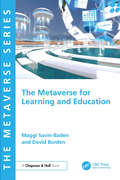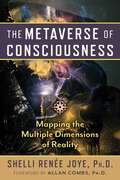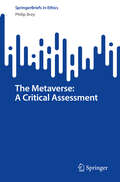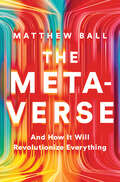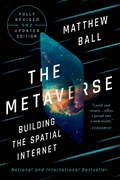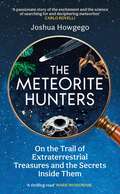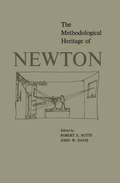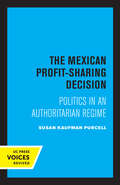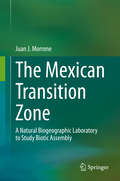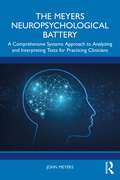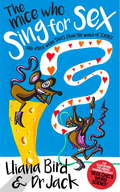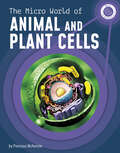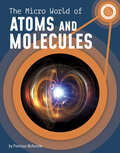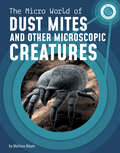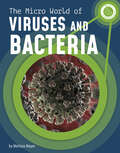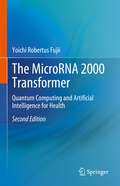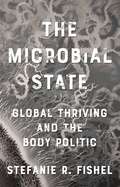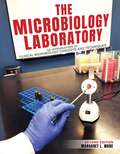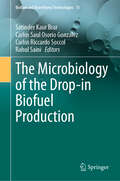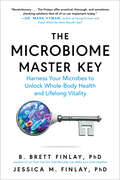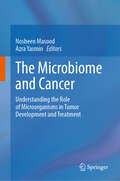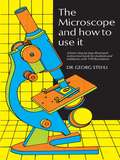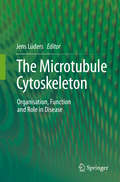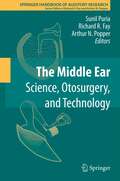- Table View
- List View
The Metaverse for Learning and Education
by Maggi Savin-Baden David BurdenAccompanying The Metaverse: A Critical Introduction in CRC Press’ new The Metaverse Series, this book explores the ways in which the Metaverse can be used for education and learning, as well as how it is different from virtual reality (VR) application development. For example, institutions and tutors can make use of the Metaverse space to represent themselves in it or create their own content and share experiences, whilst students can access a wider range of material, learn within appropriate settings and create content to support their own and others’ learning.Key Features:• Provides practical advice from the authors’ collective three decades of work and experience in VR and Metaverse learning and education.• Examines different approaches to learning that are relevant in a VR and Metaverse context, including theoretical and practical approaches to pedagogy.• Suggests different approaches to learning that might be used and explores learning in practice in the metaverse – from early versions such as computer-supported collaborative learning and action learning through to more recent practices such as games and gamification and the use of problem-based learning in virtual worlds.• Examines a number of advantages of learning in the metaverse such as the opportunity to be inclusive towards different approaches to learning, the value of affordances, peer-to-peer learning and genres of participation.This book is aimed primarily at practitioners in the learning and education field, and those who set policy and commission work. It may also be of interest to parents, managers, other interested professionals, students, researchers and lay readers.
The Metaverse of Consciousness: Mapping the Multiple Dimensions of Reality
by Shelli Renée Joye• Develops the concept of the metaverse, the &“transcendental universe,&” composed of additional hidden dimensions operating in parallel with space and time• Integrates and maps the theories of consciousness developed by Carl Jung, David Bohm, Pierre Teilhard de Chardin, and other scientists• Offers the reader a path into the hidden dimensions through detailed maps of psyche, mind, and cosmosThe "metaverse"—as this wider universe is now coming to be known—is rooted in one interconnected consciousness that encompasses space and time as well as previously unknown dimensions only recently detected. In this book, Shelli Renée Joye, Ph.D., offers ways in which to visualize, enter, and explore a multitude of these transcendent, nonspatial, and nontemporal states and stages of consciousness as she reveals vast webs of interlinked consciousness forming a single universal psyche.Joye integrates the ideas of modern scientist-philosophers who view reality as a projection of a single multidimensional consciousness: Carl Jung and his concept of the psychoids, Pierre Teilhard de Chardin and his vision of an integrated noosphere of consciousness, and the quantum maps of consciousness developed by Karl Pribram and David Bohm. The book culminates with a call to explore transcendental consciousness by developing and following our own uniquely personal paths with which we too can enter the wider dimensions of awareness in the metaverse.
The Metaverse: A Critical Assessment (SpringerBriefs in Ethics)
by Philip BreyThis book offers an extensive assessment of the nature and feasibility of the metaverse and is the first to critically examine its social and ethical implications. The metaverse is, in essence, an envisioned future merger of virtual and augmented reality (VR and AR) and the internet, enabling real-time immersive interaction and activities like work, play, socializing, and entertainment. Major tech companies like Meta, Microsoft, Apple and NVIDIA have been investing billions in metaverse technologies, with generative AI accelerating progress. This book examines how these efforts could culminate in the metaverse, exploring its potential forms, implications, and the social and ethical challenges it may pose—along with recommendations for responsible innovation. The book is aimed at stakeholders shaping the metaverse—developers, creators, investors, business leaders, and thought leaders in technologies like VR, AR, Web3, blockchain, and AI. It also serves scholars and students in applied ethics, the social sciences, and the humanities, including fields such as media studies, psychology, and law. General readers interested in the metaverse and emerging technologies will find it both accessible and engaging. Endorsements: "In this book, the talented and eloquent philosopher Philip Brey carefully explains the history and ideas behind the metaverse, and the prospects for its further development and adoption. That detailed information, meticulously presented, makes this a valuable read. But that is just the start. In later chapters, Brey just as skillfully describes the opportunities and vulnerabilities that a metaverse is likely to generate. These chapters are thorough, precise, and offer profound insights into our possible futures. Some of the possibilities are exciting. Others are frightening." –Keith W. Miller, University of Missouri–St. Louis.
The Metaverse: And How It Will Revolutionize Everything
by Matthew BallINTERNATIONAL BESTSELLER — United States, Canada, United Kingdom, and China (Wall Street Journal, Associated Press, Nielsen Bookscan, Publishers Weekly, USA Today, Toronto Star, Globe & Mail, BookNet Canada, Bookseller.com, Bookdao/Nielsen, JD, DangDang) Tim Sweeney (CEO of Fortnite-maker Epic Games): “Matthew Ball’s essays have defined, analyzed, and inspired the Metaverse for years. His book is an approachable and essential guide to the strategic, technical, and philosophical foundations of this new medium.” Derek Thompson (Atlantic staff writer and national best-selling author of Hit Makers): “This book feels like a rare achievement: a definitive statement about an emerging phenomenon that could shape the digital world, the global economy, and the very experience of human consciousness.” From the leading theorist of the Metaverse comes the definitive account of the next internet: what the Metaverse is, what it will take to build it, and what it means for all of us. The term “Metaverse” is suddenly everywhere, from the front pages of national newspapers and the latest fashion trends to the plans of the most powerful companies in history. It is already shaping the policy platforms of the US government, the European Union, and the Chinese Communist Party. But what, exactly, is the Metaverse? As pioneering theorist and venture capitalist Matthew Ball explains, it is a persistent and interconnected network of 3D virtual worlds that will eventually serve as the gateway to most online experiences, and also underpin much of the physical world. For decades, these ideas have been limited to science fiction and video games, but they are now poised to revolutionize every industry and function, from finance and healthcare to education, consumer products, city planning, dating, and well beyond. Taking us on an expansive tour of the “next internet,” Ball demonstrates that many proto-Metaverses are already here, such as Fortnite, Minecraft, and Roblox. Yet these offer only a glimpse of what is to come. Ball presents a comprehensive definition of the Metaverse before explaining the technologies that will power it—and the breakthroughs that will be necessary to fully realize it. He addresses the governance challenges the Metaverse entails; investigates the role of Web3, blockchains, and NFTs; and predicts Metaverse winners and losers. Most importantly, he examines many of the Metaverse’s almost unlimited applications. The internet will no longer be at arm’s length; instead, it will surround us, with much of our lives, labor, and leisure taking place inside the Metaverse. Bringing clarity and authority to a frequently misunderstood concept, Ball foresees trillions of dollars in new value—and the radical reshaping of society.
The Metaverse: Fully Revised and Updated Edition: Building the Spatial Internet
by Matthew BallFrom the leading theorist of the Metaverse comes the eagerly anticipated, revised and updated account of the next internet: what the Metaverse is, what it will take to build it, and what it means for all of us. A Hudson Booksellers, Amazon, Guardian, Financial Times, Economist, and ByteDance Toutiao Best Book of the Year In this substantially revised and updated edition of his internationally best-selling book, pioneering theorist and entrepreneur Matthew Ball goes beyond the hype cycle to present a definitive account of the future of the internet. The Metaverse, according to Ball’s industry-shaping definition, is a persistent and interconnected network of 3D virtual worlds that will eventually serve as the gateway to most online experiences and underpin much of the physical world. As Ball recounts, the Metaverse is a thirty-year-old term, and the core ideas and technologies behind it have been in development for nearly a century. Only recently, however, did this fantastical concept begin to leap from the pages of science fiction and depths of national research labs to the forefront of consumer technology, industrial engineering, healthcare, education, dating, and more. From the history of video games and virtual reality to “proto-metaverses” such as Second Life, Fortnite, and Roblox to Generative AI and the groundbreaking films and television series of the Walt Disney Company, Ball points out that the Metaverse is already emerging around us (and doesn’t require a headset). Still, there are many breakthroughs required to fully realize the Metaverse, and he describes each in approachable but expert detail. Ball also lays out how governmental policy, the philosophy of Big Tech leaders, artificial general intelligence, economics, and human rights will shape the development of the Metaverse. Famous for his ability to bring clarity to complex and misunderstood topics, Ball demonstrates that the race to build the Metaverse—also known as the “spatial” or “immersive” internet—is only accelerating. The Metaverse will endure as an indispensable guide for enthusiasts, tech aficionados, and anyone curious about the profound transformations underway in our increasingly interconnected world.
The Meteorite Hunters: On the Trail of Extraterrestrial Treasures and the Secrets Inside Them
by Joshua HowgegoWant to join the ultimate cosmic treasure hunt? 'They fall from the sky, and tell us about the universe: a passionate story of the excitement and the science of searching for and deciphering meteorites.' Carlo Rovelli Meteors, with their ethereal, glowing trails slashing through the atmosphere, have entranced us for centuries. But these extraterrestrial visitors are also inestimably valuable. Not just for collectors, who can make their fortunes tracking them down, but for scientists too. Meteorites are the most ancient objects we know, unblemished time capsules from the birth of the solar system. Following in the footsteps of passionate hobbyists, ground-breaking scientists and intrepid adventurers, Joshua Howgego takes a rollicking ride through the world of meteorite hunting. Join the seasoned practitioners braving the elements as they scour the Sahara and ice sheets of Antarctica. Discover how, closer to home, one unlikely hero – a self-taught jazz guitarist – is uncovering the countless micrometeorites scattered across the rooftops of our cities. And meet the professor searching for the rarest of the rare: fossil meteorites, entombed in rock since the days of the dinosaurs. Finding these stones from space is just the beginning. As scientists tease out their secrets, they piece together an unexpected new history of the solar system, with implications that extend to one of the most fundamental questions we can ask: how did life on earth begin?
The Methodological Heritage of Newton
by Robert E. Butts John W. DavisIn recent years there has been a resurgence of interest in Newton and his influence. His thought, like that of Aristotle and every other great thinker, underwent development which contemporary scholars are seeking to understand more clearly than did their predecessors, awed as they were by the overwhelming Newtonian achievement.As the titles indicate, the range of essays included in this volume is wide, but most are concerned not so much with explaining Newton's development as with assessing his contribution to the thought of others. They explore all aspects of the conceptual background--historical, philosophical, and narrowly methodological--and examine questions that developed in the wake of Newton's science. The papers are varied yet unified in their attention to common themes and show the wealth of philosophical matter to be found in scientific synthesis. Newton left a rich complexity of philosophical problems whose attempted resolution helps our understanding both of method and positive science. His theories are one of the greatest achievements in physics; they are also valuable case studies for those interested in grasping the methodological and broadly philosophical basis of science. Four of the seven essays in this volume were prepared for an international conference held at the University of Western Ontario in April 1967; the three other papers were added by the editors to supplement and unify the collection.
The Mexican Profit-Sharing Decision: Politics in an Authoritarian Regime
by Susan Kaufman PurcellThis title is part of UC Press's Voices Revived program, which commemorates University of California Press’s mission to seek out and cultivate the brightest minds and give them voice, reach, and impact. Drawing on a backlist dating to 1893, Voices Revived makes high-quality, peer-reviewed scholarship accessible once again using print-on-demand technology. This title was originally published in 1975.
The Mexican Transition Zone: A Natural Biogeographic Laboratory to Study Biotic Assembly
by Juan J. MorroneThis book presents an evolutionary biogeographic analysis of the Mexican Transition Zone, which is situated in the overlap of the Nearctic and Neotropical regions. It includes a comprehensive review of previous track, cladistic and molecular biogeographic analyses and is illustrated with full color maps and vegetation photographs of the respective areas covered. Given its scope, the book will be of interest to students and researchers whose work involves systematic and biogeographic analyses of plant and animal taxa of the Mexican Transition Zone or other transition zones of the world, and to ecologists working in biodiversity conservation, who will be able to appreciate the evolutionary relevance of the Mexican Transition Zone for establishing conservation areas..
The Meyers Neuropsychological Battery: A Comprehensive Systems Approach to Analyzing and Interpreting Tests for Practicing Clinicians
by John MeyersThis book presents detailed information on the Meyers Neuropsychological Battery (MNB) and the statistical system used to interpret the neuropsychological data patterns. By using the statistical methods a more consistent and appropriate interpretation can be made. This book contains information on normative data, performance validity, ecological validity, calculating strengths and weaknesses, comparison groups, and premorbid estimates as well as the statistical methods used with the MNB.The validity and reliability of the MNB as well as the ecological validity are all explained. Another area of detailed explanation is performance validity measures. This includes false positive rates as well as frequency of failures and passing rates for each individual performance validity measure. The statistical methods for group comparisons are demonstrated, which provides the reader with clear examples of how to apply the statistical methods to any test results. Answers are given for many of the questions asked about the MNB and the statistical methods. A modified Rohling's interpretive method is incorporated into the MNB, and demonstrates the benefit this model brings to data interpretation and practical application.This book will be an invaluable tool for clinical neuropsychologists, and all who assess and treat patients with cognitive impairment. The book is also for forensic neuropsychologists who wish to use an objective and consistent interpretive method, and lawyers and judges who wish to understand neuropsychological data and assessment.
The Mice Who Sing For Sex: And Other Weird Tales from the World of Science
by Lliana Bird Dr Jack LewisLliana Bird and Dr Jack Lewis tackle the strange and surreal phenomena from the depths of the oceans to the limits of the far flung universe; the dark corners of your laundry basket to the forgotten compartments of your fridge. Packed with unusual facts and stories of the absurd each of the fascinating insights is told with the Geek Chic team's inimitable humour and wit.An hilarious exploration all things bizarre from the world of science, The Mice Who Sing for Sex takes on weighty issues including heavy metal loving sharks, life-threatening skinny jeans, our impending jellyfish apocalypse and of course, the singing mice of the title.
The Mice Who Sing For Sex: And Other Weird Tales from the World of Science
by Jack Lewis Lliana BirdLliana Bird and Dr Jack Lewis tackle the strange and surreal phenomena from the depths of the oceans to the limits of the far flung universe; the dark corners of your laundry basket to the forgotten compartments of your fridge. Packed with unusual facts and stories of the absurd each of the fascinating insights is told with the Geek Chic team's inimitable humour and wit.An hilarious exploration all things bizarre from the world of science, The Mice Who Sing for Sex takes on weighty issues including heavy metal loving sharks, life-threatening skinny jeans, our impending jellyfish apocalypse and of course, the singing mice of the title.
The Micro World of Animal and Plant Cells (Micro Science)
by Precious McKenzieA tree and your pet look nothing alike, but they have one thing in common—they are both made up of cells. Cells are really small. You can see them only with a microscope. Young readers will find out about the parts of cells, how they work, and what the differences are between animal and plant cells.
The Micro World of Atoms and Molecules (Micro Science)
by Precious McKenzieWhat do all the things you can see and touch in the universe have in common? Atoms! Made up of electrons, protons, and neutrons, atoms are so tiny you can’t see them without special microscopes. Young readers will find out about the parts of atoms, how atoms join to form molecules, and their role in the periodic table of elements.
The Micro World of Dust Mites and Other Microscopic Creatures (Micro Science)
by Melissa MayerDid you know that there are animals all around you that you can’t see without a microscope? Sometimes it’s good you can’t see them. As you shed dead skin cells, thousands of dust mites gobble them up. Gross! Tiny water bears are super tough. They can survive in Earth’s coldest and hottest places and even in space! Young readers will learn amazing, weird, and sometimes gross facts about a variety of microscopic creatures.
The Micro World of Viruses and Bacteria (Micro Science)
by Melissa MayerThe world is full of tiny viruses and bacteria that can be seen only through a microscope. Some bacteria can be helpful, but others cause diseases such as typhoid fever. Viruses can cause deadly diseases such as COVID-19. Young readers will get all the facts about bacteria and viruses, including their similarities and differences, how they cause infections, and how people can keep dangerous germs from spreading.
The MicroRNA 2000 Transformer: Quantum Computing and Artificial Intelligence for Health
by Yoichi Robertus FujiiThe second edition includes new findings that were only a theory in the first edition, clarifying what is beginning to be proven true. All chapters have been updated, and new data on the analysis of major depressive disorder from exosome microRNA (miRNA) in plasma, traumatic brain injury, and Alzheimer's disease, brain glioma from cerebrospinal fluid miRNA, liver cancer, induced pluripotent stem (iPS) cell tumorigenesis, and other topics have been added. As predicted in the first edition, diseases can be predicted using the miRNA memory package (MMP) and miRNA entangling target sorting (METS), which could clarify the etiology of human diseases. Because researchers are investigating the relationship between circulating miRNAs and human diseases to develop new medicines, miRNA deep sequencing and detection methods will be high-speed and clever. The microRNA 2000 Transformer - Quantum Computing and Artificial Intelligence for Health is aimed at intermediate and advanced scientists, clinicians, students, and science enthusiasts. The Author hopes to lay the groundwork for future human health innovation.
The Microbial State: Global Thriving and the Body Politic
by Stefanie R. FishelFor three centuries, concepts of the state have been animated by one of the most powerful metaphors in politics: the body politic, a claustrophobic and bounded image of sovereignty. Climate change, neoliberalism, mass migration, and other aspects of the late Anthropocene have increasingly revealed the limitations of this metaphor. Just as the human body is not whole and separate from other bodies—comprising microbes, bacteria, water, and radioactive isotopes—Stefanie R. Fishel argues that the body politic of the state exists in dense entanglement with other communities and forms of life. Drawing on insights from continental philosophy, science and technology studies, and international relations theory, this path-breaking book critiques the concept of the body politic on the grounds of its very materiality. Fishel both redefines and extends the metaphor of the body politic and its role in understanding an increasingly posthuman, globalized world politics. By conceiving of bodies and states as lively vessels, living harmoniously with multiplicity and the biosphere, she argues that a radical shift in metaphors can challenge a politics based on fear to open new forms of global political practice and community. Reframing the concept of the body politic to accommodate greater levels of complexity, Fishel suggests, will result in new configurations for the political and social organization necessary to build a world in which the planet&’s inhabitants do not merely live but actively thrive.
The Microbiology Laboratory: An Introduction to Clinical Microbiology Concepts AND Techniques
by Margaret WareThe goal of this text is to instill a basic curiosity about and respect for microorganisms as students prepare for their future health care professions. The Microbiology Laboratory: An Introduction to Clinical Microbiology Concepts and Techniques promotes the understanding of how microorganisms live and spread, as well as how to deter their presence when needed. This text stresses the importance of constant vigilance in both quality control and infection control practices. Using simulated patient cases, the text introduces identification techniques as well as the importance of effective communication in quality patient care. Experiments utilize demonstration, critical thinking, and discovery to clarify and solidify important concepts regarding microbial life while remaining directly applicable to challenges encountered daily. In addition to the more traditional activities, several exercises draw directly from student discussion of current events to utilize hands on exploration of relevant questions. The introduction to each lab exercise provides background information to help solidify the “why” behind the many details found in best practices required of health care professionals. The knowledge and experiences gained through these lab activities contribute to an early development of vigilant microbial control practices as a lifelong habit. This text requires little previous science background and assumes only basic math skills. Exercises do not require a large investment in equipment, utilizing hands-on experiences over automated alternatives, making it suitable for a wide variety of instructional situations.
The Microbiology of the Drop-in Biofuel Production (Biofuel and Biorefinery Technologies #15)
by Satinder Kaur Brar Carlos Saul Osorio Gonzalez Carlos Riccardo Soccol Rahul SainiThe Microbiology of the Drop-in Biofuel Production is a comprehensive resource that provides basic and applied knowledge, technologies, and regulations of current drop-in biofuel production. This book focuses on liquid drop-in biofuel produced trough biochemical process and all the important aspect like renewable substrates, biochemical routes, genetic modifications, technology innovations, regulation, commercialization as well as the future perspectives to be implemented. Starting with an introductory chapter about the conventional methods to produce drop-in biofuels, the book will guide the reader into the specific biochemical processes for its production, covering aspect like renewable feedstocks, microorganism, classification, and the circular economy around all the production process. This book provides a detailed overview about the microbiology, regulation and commercialization aspects of drop-in biofuel production and is essential for researchers, students, and professors working in the bioenergy area.
The Microbiome Master Key: Harness Your Microbes to Unlock Whole-Body Health and Lifelong Vitality (Second Edition)
by B. Brett Finlay Jessica M. FinlayLearn the secret to whole-body, lifelong health: the teeming world of microbes inside and all around you. Hand sanitizer. Social distancing. Antibiotics. Fending off germs has long been considered one of the cornerstones of good health. But what if better health and more graceful aging actually went hand-in-hand with embracing microbes? Your body is teeming with microbes—not just in the gut, but also on your skin, in your lungs, and beyond. And they impact everything from your sleep, cognition, mood, heart health, and energy to your likelihood of developing many diseases. As groundbreaking new studies are showing, taking care of your microbiome—inside and out—can help you improve your day-to-day health and even help prevent or reverse some of the most common age-related diseases. This eye-opening book breaks down what the latest research says about how the microbiome affects all aspects of physical and mental health—and what you can do about it. Potentially change the trajectory of 9 out of 10 leading causes of death, including heart disease, cancer, lung disease, stroke, Alzheimer’s disease, and diabetes Increase your resistance to pathogens like the flu and COVID-19 Keep your skin soft, healthy, supple, and less wrinkled Stabilize your weight and control blood sugar Improve your physical fitness and strength Fight “inflammaging”—low-grade inflammation that hastens the aging process Get a more restful and rejuvenating night’s sleep Reduce stress and improve mental health—and your long-term quality of life The Microbiome Master Key is an updated and expanded new edition of The Whole-Body Microbiome.
The Microbiome and Cancer: Understanding the Role of Microorganisms in Tumor Development and Treatment
by Nosheen Masood Azra YasminThis book explores the intricate relationship between microorganisms and cancer. It begins by discussing the microbiome of the human body and its role in cancer development. The cellular organization of tumors is also explored in detail. The book then delves into the specific microorganisms that have been associated with various types of cancer. The role of HCV in hepatocellular carcinoma is discussed in depth, as well as cancers associated with EBV. Further, it also explores the link between HPV and urogenital and head and neck cancers, and Kaposi’s sarcoma-associated Herpes virus. The chapter is dedicated to dispelling myths surrounding Aspergillus and lung cancer and examines the complications associated with fungal infections in cancer treatment. The book then explores the link between parasites and cancer, and the role that protists play in cancer development. Finally, the book concludes with a discussion of cancer management and therapies related to microorganisms. Overall, the book provides a comprehensive overview of the relationship between microorganisms and cancer and sheds light on how this relationship can be harnessed for more effective cancer management and treatment.
The Microscope and How to Use It
by Georg StehliA world of pleasure, excitement and new knowledge awaits one who learns to use the microscope — a world in which table salt crystals appear as jewels, a drop of water swarms with life, a butterfly's wings reveal a cascade of multicolored particles. This book is for anyone who would like to enter that world, whether or not he has ever used a microscope before. No special knowledge is required. In non-technical language and with generous use of illustration, the author explains how a microscope works and what kind to use; how to adjust the instrument and position the specimens to be viewed; examination of simple objects: a human hair, feathers, milk. At the same time, he shows how to prepare the objects, what to purchase for the purpose, how to care for it; one's every question is anticipated and clearly answered. The fundamentals understood, the reader is taken into further exploration viewing insect parts, diatoms, plankton, molds, leaves, ferns, fruit rinds, fish scales, animal parts. As we proceed, we learn step by step the techniques involved: use of chloroform, preparation of permanent slides, mounting in glycerine, preparing dye solutions, dissection, and blood smearing. We learn how to detect fat, find Vitamin C in food substances, prepare a frog for examination, view and distinguish bacteria, use the oil-immersion objective, dye bacilli spores, do microphotography, cut sections with the microtome. Following Dr. Stehli's careful instructions, we have entered and gone well into the fascinating world of microscopy. The invention of the microscope itself started science on new courses, entire fields of new knowledge. The use of a comparatively simple microscope today can start one on a lifetime interest, an absorbing hobby, a career in science, or a permanent addition to one's cultural background. This book provides all the help needed, whether one is adult or student, hobbyist or scientifically serious, seeking education or merely curious about the minute world that exists all about us. 119 photographs and drawings.
The Microtubule Cytoskeleton
by Jens LüdersThis book provides an overview on the organization andfunction of the microtubule cytoskeleton, which is essential to many cellularprocesses and profoundly linked to a range of human diseases. Covering basic concepts as well as molecular details, the book discusses howmicrotubules are nucleated and organized into ordered arrays, at different cellcycle stages and in distinct cell types. In addition, the book highlights howdefects in the microtubule cytoskeleton are linked to diseases such asneurodevelopmental disorders. The book is intended for students, graduates and moresenior researchers in cell and developmental biology as well as for medicaldoctors.
The Middle Ear
by Arthur N. Popper Richard R. Fay Sunil PuriaThe middle ear plays a vital role in the sense and sensitivity of hearing. Of the various characteristics that distinguish mammals from other vertebrates, several pertain specifically to the middle-ear system, such as the presence of three middle-ear bones and the four-layer composite structure of the tympanic membrane. The Middle Ear attempts to elucidate the role this system plays in sound transmission, as viewed from both scientific and clinical perspectives.
